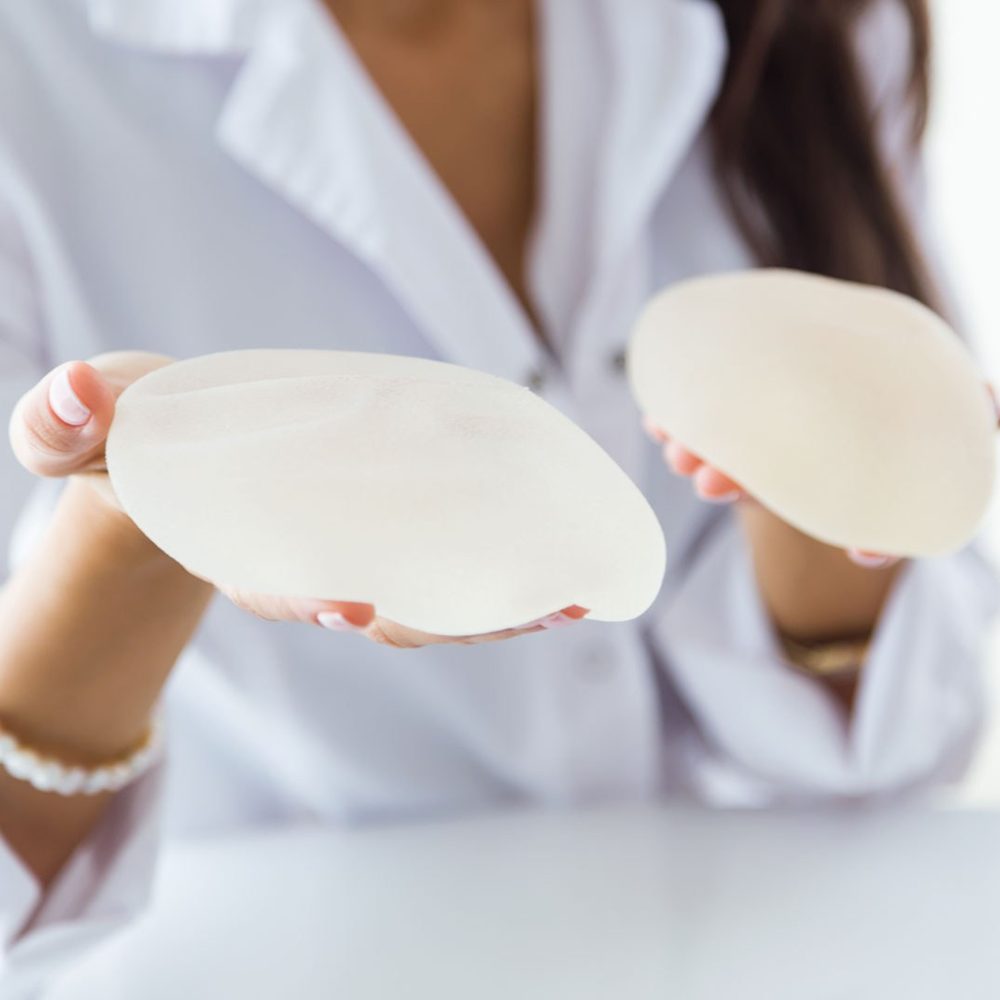While many people think of breast implants in terms of cup size, breast augmentation sizing is far more complex. It involves factors such as implant volume, projection, body proportions, and personal lifestyle, to achieve results that feel natural, balanced, and right for you.
Understanding Implant Sizing: CCs vs. Cup Size
Breast implants are measured in cubic centimetres (cc), which refers to the volume of the implant. The higher the cc, the larger the implant. In most cases, implants range from about 125cc to 800cc or more. Unlike bras, which are sized using band and cup measurements (e.g., 12C, 14D), implants don’t directly translate into a specific cup size. This is because bra sizing varies significantly between brands, styles, and even countries. For example, a 300cc implant might result in a C cup on one woman but a B cup or D cup on another, depending on her body shape, chest width, and natural breast tissue.
Instead of focusing solely on cup size, surgeons use implant volume, diameter, and projection to help create a breast shape and size that looks proportionate to the individual’s body.
Factors to Consider When Choosing Breast Implant Size
1. Your Body Frame and Proportions
Your natural body proportions play a significant role in how an implant will look on you. A petite woman with a narrow chest may find that even a modest implant creates a fuller appearance, while someone with a broader chest or taller frame may need a higher-volume implant to achieve a similar effect.
Chest width, shoulder breadth, hip proportions, and overall body balance all need to be considered. The goal is usually to enhance your figure in a way that looks harmonious and natural, rather than simply selecting a large implant size.
2. Your Starting Point: Natural Breast Tissue
The amount of existing breast tissue also affects the outcome. Women with more natural breast tissue can often accommodate a broader range of implant sizes while still maintaining a natural appearance. Those with very little natural tissue may need to consider moderate implant sizes to avoid issues such as visible implant edges or rippling.
3. Desired Look and Personal Goals
Every woman has her own vision of what she wants her breasts to look like after augmentation. Some aim for a subtle, natural enhancement, while others prefer a fuller, more dramatic appearance.
It’s also important to think about whether you want your results to be discreet or more noticeable. While a larger implant may deliver a glamorous, high-profile look, many women prefer a size that complements their figure without drawing excessive attention.
4. Lifestyle and Physical Activity
Your daily activities and lifestyle should also guide your choice. For example, athletes, runners, or women who regularly participate in high-impact exercise may prefer smaller implants that won’t interfere with comfort or movement. Larger implants can add weight and may influence posture, so it’s important to balance aesthetics with functionality.

5. Implant Profile, Projection, and Fullness
In addition to size, implants come in different profiles—low, moderate, moderate plus, and high profile. Implants can have the same volume (e.g. 400 cc), but different profiles (low vs high), which means different final breast projections and shapes. The profile refers to how far the implant projects from the chest wall.
- Low profile implants are generally suited for wider chests and are flatter in appearance, with minimal projection, providing subtle projection.
- Moderate profile implants offer balanced width and projection, often producing a more natural-looking result.
- High profile implants are generally suited for narrower chests but project further outward, creating a more prominent cleavage.
Choosing the right profile is just as important as choosing the right volume, as it influences not only breast size but also shape and overall proportions.
Another aspect of implant selection is how full the implants are, sometimes referred to as the fill volume. The fill volume determines how firm and round the breasts will appear after augmentation. Dr Turner uses silicone breast implants of the highest quality, which come pre-filled with a set volume of cohesive silicone gel. This means their fullness and shape are consistent and predictable. The choice of how much the implant is filled is made collaboratively between the patient and surgeon, taking into account the desired look, feel, and overall balance with the patient’s body proportions.
6. Future Considerations
Breast implants are not considered lifetime devices. Over time, changes such as pregnancy, breastfeeding, weight fluctuations, and the natural ageing process may affect the way your breasts look. While you may love a particular size now, it’s worth considering how that choice will age with your body. A natural, proportionate size often adapts more comfortably to these changes over time.
How Many CCs Equal a Cup Size?
One of the most common questions women ask is how many cc’s it takes to go up a cup size. While there is no definitive answer due to everyone’s unique circumstances, a general guideline is that each 150cc to 200cc increase in implant volume may translate to one bra cup size increase.
However, this varies considerably based on chest width and existing natural breast tissue. For example, a 200cc implant might create a noticeable change on a smaller frame but only a subtle difference on a larger frame.
Because of these variables, breast implant options and sizing are best approached as a personalised process in consultation with your plastic surgeon rather than focusing solely on achieving a specific cup size.
Balancing Expectations with Professional Guidance
Many women arrive at a consultation with a specific cup size in mind, but a more effective approach is to focus on the overall look they want to achieve. Clear communication with your surgeon about your goals—whether that’s natural enhancement, a curvier figure, or a fuller cleavage—will help guide size recommendations.
Your surgeon will also consider critical medical factors, such as tissue quality, skin elasticity, and chest anatomy, before recommending suitable implant sizes.
Common Mistakes to Avoid in Implant Sizing
- Choosing purely by cup size: As discussed, cup size is an unreliable measurement when it comes to implants.
- Selecting a size too large for your frame: While larger implants can look appealing in photos, they may create long-term issues such as discomfort, sagging, or an unnatural appearance.
- Not considering future lifestyle changes: Pregnancy, weight changes, or a shift in activity level may affect how happy you are with your chosen size.
- Ignoring profile and shape: Volume alone does not determine the final look—implant profile and projection are equally important.
Choosing the right breast implant size is a deeply personal decision that requires careful thought and professional guidance. While cc measurements and cup sizes provide a starting point, the best results come from considering your body proportions, lifestyle, and long-term goals.
A consultation with your qualified plastic surgeon is the best way to explore your options, review before-and-after examples, and discuss implant profiles to find the combination that feels right for you.
Breast augmentation is about more than increasing size—it’s about achieving balance, confidence, and results that feel natural to your body.
